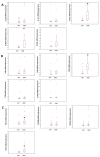Gestational Diabetes Mellitus-Induced Inflammation in the Placenta via IL-1β and Toll-like Receptor Pathways
- PMID: 39518962
- PMCID: PMC11546908
- DOI: 10.3390/ijms252111409
Gestational Diabetes Mellitus-Induced Inflammation in the Placenta via IL-1β and Toll-like Receptor Pathways
Abstract
Gestational diabetes mellitus is characterised by an insufficient insulin response to hyperglycaemia and the development of insulin resistance. This state has adverse effects on the health outcomes of the mother and child. Existing hyperglycaemia triggers a state of inflammation that involves several tissues, including the placenta. In this study, we analysed the putative pathomechanism of GDM, with special emphasis on the role of chronic, sterile, pro-inflammatory pathways. The expression and regulation of the elements of IL-1β and Toll-like receptor (TLR) pathways in GDM maternal blood plasma, healthy placental explants and a choriocarcinoma cell line (BeWo cell line) stimulated with pro-inflammatory factors was evaluated. Our results indicate elevated expression of the IL-1β and TLR pathways in GDM patients. After stimulation with IL-1β or LPS, the placental explants and BeWo cell line showed increased production of pro-inflammatory IL-6, TNFa and IL-1β together with increased expression of the elements of the signalling pathways. The application of selected inhibitors of NF-ĸB, MAPK and recombinant interleukin 1 receptor antagonist (IL1RA) proved the key involvement of the IL-1β pathway and TLRs in the pathogenesis of GDM. Our results show the possible existence of loops of autocrine stimulation and a possible inflammatory pathomechanism in placentas affected by GDM.
Keywords: GDM; gestational diabetes mellitus; inflammation; interleukin.
Conflict of interest statement
The authors declare no conflicts of interest.
Figures







References
-
- International Diabetes Federation. [(accessed on 7 December 2021)]. Available online: https://diabetesatlas.org/data/en/indicators/14/
-
- Maedler K., Sergeev P., Ris F., Oberholzer J., Joller-Jemelka H.I., Spinas G.A., Kaiser N., Halban P.A., Donath M.Y. Glucoseinduced beta cell production of IL-1beta contributes to glucotoxicity in human pancreatic islets. J. Clin. Investig. 2002;110:851–860. doi: 10.1172/JCI200215318. - DOI - PMC - PubMed
MeSH terms
Substances
LinkOut - more resources
Full Text Sources

